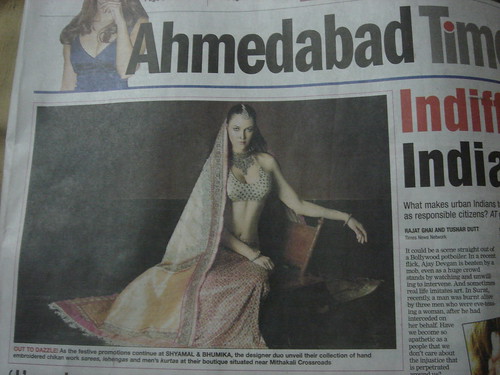
Here is their storefront. It's really beautiful. Their entire store would fit perfectly into any fancy street in LA, New York, or Tokyo.
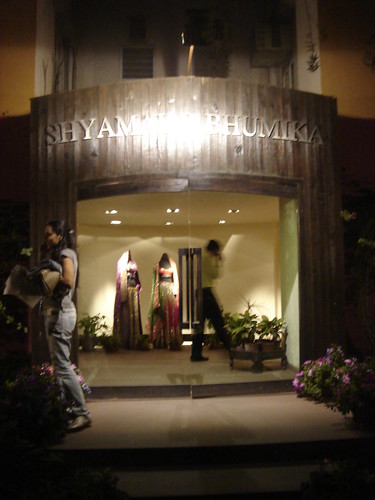
The inside, and the clothing, are all blindingly colorful and lovely.
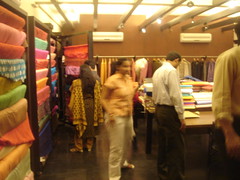
But where do all these clothes, materials, and designs come from? I can share a small amount of information, not because of any particular non-disclosure agreements that may or may not have been signed, but because I know very little.
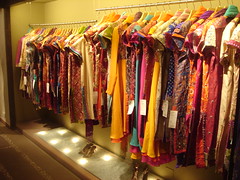
Pictured below is Ishani (Shalin's cousin), a professional textile designer working for the aforementioned concern. She is designing a pattern in illustrator that will be embroidered onto a fabric.

She must consider not only the repeating composition, but also how it will be stitched as a continuous thread. Of course, it has to look nice, too. Embroidery, for those of you filling those shoes I, until only recently, occupied, means that thread is sewn into an existing fabric, creating a design. Those who are not squeamish about prematurely revealed endings, may scroll down to a hand embroidered detail below.
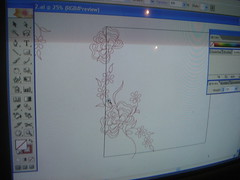
I never realized that nowadays, someone sits down and designs these patterns. I thought there were simply standard patterns that are copied and pasted. Not at all, it turns out. India has a long history of textile design & production. Ishani looked at lots of reference material before undertaking the above pattern. Some are created from her imagination, such as this bed sheet design (below).

She says that India has a huge library of traditional designs and art to draw from. By way of example, here is a curtain from Shalin's house.
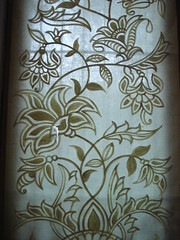
The designer/philospher Christopher Alexander comes to mind, who claims that good designs reuse historically, organically, evolved patterns. The fifteen properties Alexander argues are fundamental to the universe and good design, such as strong centers, symmetry, and boundaries, are all obviously at play here, as well as the traditional Indian visual design language.
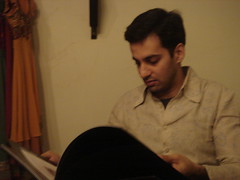
Here are our eponymous heroes, hard at work.
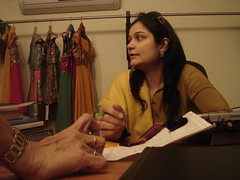
Bhumika is discussing design, and directing her staff. Actually, I have no idea what she's doing, because the conversation is not in English. But, familiar with game production & design, a similarly industrialized creative process, I immediately understood what was going on. Designs were discussed, samples reviewed, feedback given, and direction decided. Bhumika is pregnant, and is still working very hard, despite the fact that the baby is due soon!
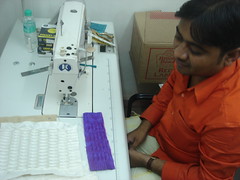
Many of their textiles are hand woven, hand embroidered, designed in house, and assembled in house. From sales to production to design, it's an entirely integrated operation. In a different location is a team of about 70 folks, if memory is correct, building the actual clothes. In house, they have a team of about 5 doing alterations, and prototyping materials and designs. Above, you can see a tailor with a test material he has produced, to be reviewed by the designers. Below, a tailor is assembling some clothing out of a hand-embroidered material.

I learned a few more things about the fashion industry. Those catwalks, populated by models, are a critical part of the biz. Right now, this shop is trying to complete a collection that will be displayed in Mumbai, alongside other designers' work. The catwalk is an advertisement for buyers. Buyers will put in orders, and ask for changes -- all in time for seasonal fashion changes.
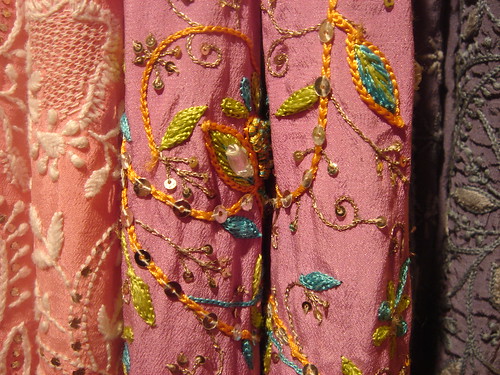
Above, a detail of some hand embroidered clothing. Some of these wedding saris take 5 people 2 months to make, and the one I looked at cost approximately $600 USD. That's about a year of labor, total. 40 Rs (Rupees) is about 1 USD, and a meal in India is about 40 Rs. Their primary clientèle, I understand, are Indians living abroad.
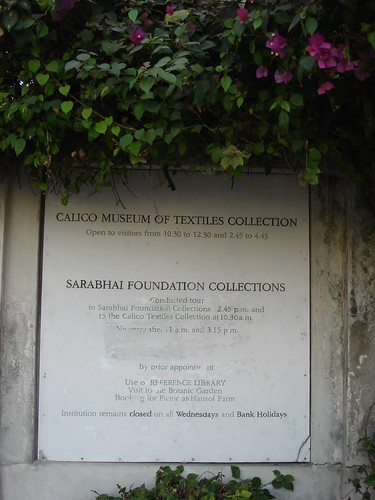
Determined to learn more, Sulay (Ishani's brother, and Shalin's cousin) and I undertook an expedition to Ahmedabad's Calico Textile Museum. Tours by prior appointment. Photography not allowed. Words are, naturally, the wrong medium with which to paint for you what I have witnessed, but they must suffice.
If you find yourself in Ahmedabad, this tour is absolutely worth undertaking. The grounds and architecture of the museum are alone worth the price of admission, which happens to be free. But even if it were not free, the grounds alone would be worth the visit to the museum. I saw parrots, peacocks, and humming birds in the gentle gardens that surround the place.
When I was young, I was always bored by museums like this. Now, using my imagination -- a hard earned Graphics History Visualization Engine (GHVE) -- I find it more enjoyable. If I look at a dull flag, I imagine it bright and colorful, as it once was, leading an army unit of Gujarati warriors, waving in the wind. Kids must be awesome bored here -- you need someone to bring it to life. Our tour guide, and the exhibits, feed my GHVE with enough data to go on. There's so much to see here, we barely touch a fraction of it on the tour, and I describe a fraction of what I've seen below.
We see a long hand painted scroll depicting a historical event. A storyteller, armed with a candle and musical accompaniment, would narrate the events depicted here. Ancient made for TV news drama. Alone, like history, it's just a scroll. With a storyteller, it's magic.
Textiles made in Gujarat were found in the Egyptian pyramids. Apparently, they were exported to royalty in Bali, Japan, and Egypt. Lots of interesting, and time consuming, techniques are used to make these fabrics. Paisley patterns have an Indian origin -- they are the bottom of a clenched fist dipped in paint. Tie-dye was originally, and remains, a technique for patterning a textile by applying minute drops of wax to carve out an elaborate pattern. I saw embroidery so detailed and rich that the detail above looks like a hack job. And some wacky Atari 2600 looking materials made from pre-dyed threads, which are then woven together, producing a pixelated pattern.
Most interesting to me is the link between how humans make dimensional structures, and how nature does it. We are, when we make origami, or spinning thread from shorter natural fibers, sewing, weaving, casting -- increasing the dimensionality of our materials into more and more sophisticated shapes, forms of higher dimensionality. We have devised elaborate technologies for doing so. Computers, which have simple linear memories, use software to fold this single linear thread of memory into complex data structures, three dimensional graphics, and sophisticated organizational structures. All of computer science is reducible, in some way, to this endeavor, much like organic chemistry, or textile production.
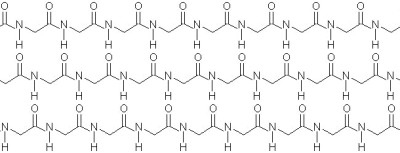
We're not too far off from how the natural world does it. In the case of many organic forms, elements are arranged in arrays, coils (threads), and woven into tissues, which are folded and glued into three dimensional organs. When we humans make clothing, we start from natural plant and animal fibers, leveraging what billions of years have naturally evolved for us. We turn these fibers into longer threads, which we then arrange into two dimensional fabrics, from which we create clothing, tents, bags, paper, and kinds of other beautiful and useful forms.
4 comments:
Wow, Shyamal looks almost exactly like Shalin. Which I guess isn't that surprising. But still!
Awesome. I miss the intricate discussions on the seemingly mundane.
/me walks away with a new appreciation for textiles!
Fascinating post.
I love the melding of art, philosophy, computers, history!! You Must eventually take to teaching!
Post a Comment